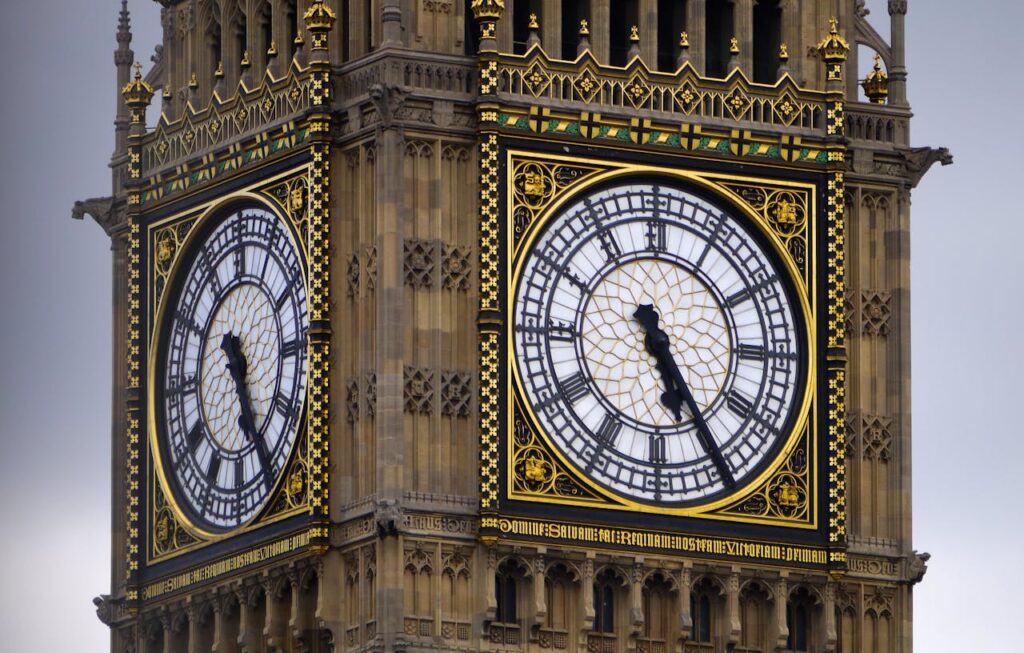
The Icon of London
Dominating the skyline of Westminster, Big Ben stands as a defining symbol of London, a monolithic figure that both residents and tourists identify with the city.
Its familiar silhouette, seen in photographs and films around the world, is a testament to its architectural prowess and historical significance.
Yet, despite its fame, the tower known as Big Ben is often misunderstood, with most people mistakenly referring to the clock tower itself by this name. In truth, Big Ben refers only to the Great Bell housed within.
This tower, officially called the Elizabeth Tower, represents a harmonious blend of Victorian engineering and cultural importance.
Big Ben’s Historical Background
The Origin of Big Ben’s Name
The story behind Big Ben’s name is as intriguing as the tower itself. The bell was cast in 1858 and named “Big Ben,” a nickname that many believe was inspired by Sir Benjamin Hall, the engineer who oversaw the installation of the bell.
Hall, a large man, earned the moniker due to his imposing stature. An alternative theory links the name to Benjamin Caunt, a popular heavyweight boxer of the time.
Regardless of its true origin, the name Big Ben has endured, becoming synonymous with the tower, the clock, and London itself.
Architectural Grandeur
A Marvel of 19th-Century Engineering
The Elizabeth Tower, completed in 1859, represents an impressive feat of 19th-century engineering. Rising 316 feet (96 meters) above the ground, the tower showcases Gothic Revival architecture, with intricate stone carvings and imposing features that exude both elegance and strength.
Architect Charles Barry, in collaboration with Augustus Pugin, crafted this masterpiece as part of the Palace of Westminster’s rebuilding after a devastating fire in 1834.
The clock face itself measures 23 feet (7 meters) in diameter, and its iron frame supports 312 individual pieces of opal glass, making it one of the largest and most intricate clock faces in the world.

The Clock Mechanism
Precision and Power in Every Tick
What sets Big Ben apart from other clock towers is not just its size but the precision of its clock mechanism.
Designed by Edmund Beckett Denison and installed by Edward John Dent, the clock was revolutionary in its time.
The pendulum, housed in a windproof box, swings every two seconds, driving the clock’s hands with mechanical exactitude.
The use of gravity escapement, an innovative mechanism, allows for near-perfect timekeeping despite the weight of the clock’s hands, which are heavy enough to be affected by wind and other external forces.
In the 19th century, it was one of the most accurate clocks in the world.
The Great Bell
The Voice of Big Ben
The bell itself, known as Big Ben, weighed an astounding 13.5 tons (13.76 metric tonnes) and was cast by Whitechapel Bell Foundry, one of the oldest and most respected bell manufacturers in the world.
When first installed, Big Ben cracked during a test ring, leading to a repair that shifted the striking point to avoid further damage.
The bell’s sonorous chime resonates through central London, signalling the hour with a deep and solemn tone.
For locals, hearing Big Ben’s chimes is not just an indication of time—it is a rhythmic reminder of the city’s heart still beating with tradition.
Big Ben’s Cultural Significance
More than Just a Clock Tower
Big Ben is far more than a marvel of engineering or an elegant tower in London’s skyline. It is an enduring symbol of British resilience and stability, often seen as the voice of the nation itself.
During times of national significance, whether jubilant or sombre, the chimes of Big Ben accompany moments of reflection.
Its resonance has been heard during royal weddings, state funerals, and even national broadcasts, often symbolizing both continuity and change in the country’s history.
The tower has become a beloved figure in the British collective consciousness, offering a sense of constancy amidst a rapidly changing world.
Big Ben Through Wartime
Surviving Bombs and Blackouts
Big Ben has withstood the test of time, including the ravages of war. During World War II, the tower endured several close calls as German bombing raids targeted London.
Despite significant damage to the nearby Palace of Westminster, Big Ben and its clock face remarkably survived.
The clock continued to function throughout the war, even during the Blitz, when blackout conditions across the city obscured its illuminated face.
The sound of Big Ben’s chimes during these dark times became a symbol of defiance and hope, reminding the British public that even under the threat of destruction, the heart of London remained unshaken.
Big Ben Recent Renovations
Restoring an Icon for the Future
After decades of continuous operation, Big Ben underwent an extensive renovation starting in 2017, with the work expected to last several years.
The goal was to restore the Elizabeth Tower to its former glory while modernizing certain elements, including updating the clock’s mechanical systems and reinforcing the structure to withstand modern environmental pressures.
During this time, the iconic chimes were silenced, except on special occasions, as engineers and craftsmen painstakingly worked to repair and conserve the tower’s delicate features.
The renovation serves as a reminder that even the most timeless icons require care and maintenance to continue their legacy.
Big Ben in Popular Culture
A Global Symbol in Film, TV, and Literature
Big Ben’s image transcends its physical presence, becoming an emblem of British culture in media across the globe.
Its likeness has appeared in countless films, television shows, and books, often serving as a shorthand for London or England as a whole.
Whether in the background of a spy thriller or featured prominently in historical dramas, the clock tower’s silhouette is instantly recognizable.
It has also been immortalized in works of literature, from Charles Dickens to modern-day writers, symbolizing everything from political power to the passage of time.
As an icon, Big Ben represents both a tangible and abstract sense of British identity.
Big Ben Visitor Experience
What to Expect When Visiting Big Ben
For those lucky enough to visit Big Ben, the experience offers a unique glimpse into history and architecture.
Although public tours inside the Elizabeth Tower are currently restricted to UK residents, visitors can still admire its grandeur from the outside.
Standing at the foot of the tower, one can truly appreciate its sheer scale and the intricacy of its design.
Nearby, the Houses of Parliament and Westminster Abbey provide additional layers of historical context, making this area of London one of the most culturally significant and awe-inspiring sites in the city.
While Big Ben is best experienced in person, its resonance and symbolism echo far beyond London’s borders.
Subscribe to our newsletter for the latest updates, events, and hidden gems in London!
